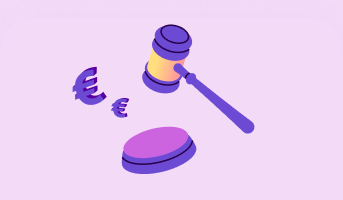As a self-employed individual with a sole proprietorship, your income is taxed under the personal income tax regime. But even if you have a company and receive a salary as a company director, you report this through your personal income tax declaration.
In Belgium, personal income tax operates on the basis of progressive tax brackets, which increase as your income rises. This is in contrast to flat taxes, such as corporate tax and VAT, where you always pay the same tax rate.
How do tax brackets in Belgium work?
The Belgium tax brackets are designed to protect those earning the lowest wages and make the tax system as fair as possible. In this way, the government can levy higher taxes on higher wages, while everyone still pays the same tax rate per bracket. Those who earn more only pay the higher tax rate on the higher portion of their income.
These tax brackets prevent scenarios where higher earners ultimately end up with less than those who earn less – which would be the case if a higher tax rate was applied to the entire wage. It would then no longer be worth pursuing that wage increase or opting for a better-paid job with more responsibility. Ambition and motivation would effectively be penalised, which would harm the economy.
How much tax do you have to pay when you’re self-employed in Belgium?
To calculate how much personal income tax you have to pay as a self-employed individual in a sole proprietorship or as a company director in a company, it’s essential to understand the progressive tax brackets.
Tax brackets Belgium 2025
In Belgium, there are four tax brackets: 25%, 40%, 45%, and 50%. These are the tax brackets for the tax year 2025 (declaring 2024 income):
| Bracket 1 | €0.01 to €15,820 | 25% |
| Bracket 2 | €15,820 to €27,920 | 40% |
| Bracket 3 | €27,920 to €48,320 | 45% |
| Bracket 4 | Over €48,320 | 50% |
You can always find the current amounts on the FPS Finance website.
The tax-free amount
Furthermore, everyone is entitled to a tax-free amount. In 2025 (declaring 2024 income), this amounts to €10,570. This, however, doesn’t mean you pay zero income tax on the first €10,570 you earn. The name ‘tax-free sum’ is slightly misleading, as in reality it’s more of a discount on your taxes.
It works like this: the tax-free amount of € 10,570 is subject to the progressive tax rates, the first bracket in this case. This means the tax-free amount is € 10,570 x 25%, which amounts to € 2,642.50. This means you’re eligible for a ‘tax discount’ of € 2,642.50 on your total taxes.
The tax-free amount is sometimes further increased depending on your personal situation, for example, if you have children or another dependent family member. Expenses like childcare, pension savings, or donations all have an impact on your taxable income too.
However, even without this information, you can already get an idea of the taxes you will have to pay. The final amount will probably just be slightly lower, depending on your personal situation.
Belgium tax brackets: the calculation
To calculate your taxes, you need to know your total taxable amount on an annual basis. In a sole proprietorship, this is the amount left after VAT, professional expenses, and social security contributions.
First, you subtract the tax-free amount from this. Then you calculate the taxes for each bracket and add these results together.
Example
Suppose you earned a net taxable income (excluding VAT, social contributions, and professional expenses) of €50,000 in 2024. You need to set aside around € 16,172.50* for personal income tax. Here’s the calculation:
| Tax bracket | Taxable base | Tax rate | Taxes due |
| Bracket 1: €0.01 to €15,820 | €15,820 | 25% | €3,955 |
| Bracket 2: €15,820 to €27,920 | €12,100 | 40% | €4,840 |
| Bracket 3: €27,920 to €48,320 | €20,400 | 45% | €9,180 |
| Bracket 4: Over €48,320 (in this example up to € 50,000) | €1,680 | 50% | €840 |
| Total taxes | € 18,815 | ||
| Total taxes after tax-free amount | € 16,172.50 |
*In reality the total amount of tax to pay may slightly vary, as depending on where you live in Belgium, you also pay communal taxation.
Time for some smart professional expenses
That’s a significant chunk of your hard-earned income going to the tax authorities. But as a self-employed individual, you obviously have a way to reduce your taxes: professional expenses. If you incur expenses and make investments for your business, these are tax-deductible, and you can deduct them from your profit. By smartly claiming business expenses, you reduce the total taxable base and thus pay fewer taxes.
Are you unsure about which professional expenses you can claim and at what exact percentages? Be sure to check our professional expenses database. Perhaps there are costs you’re not currently claiming, simply because you haven’t thought of them yet.
Would you like to have a clear view of your income and taxes at all times? If you track your income and expenses through Accountable, you’ll know at any moment how much you’ve earned net and how much you still need to set aside for taxes and VAT.
